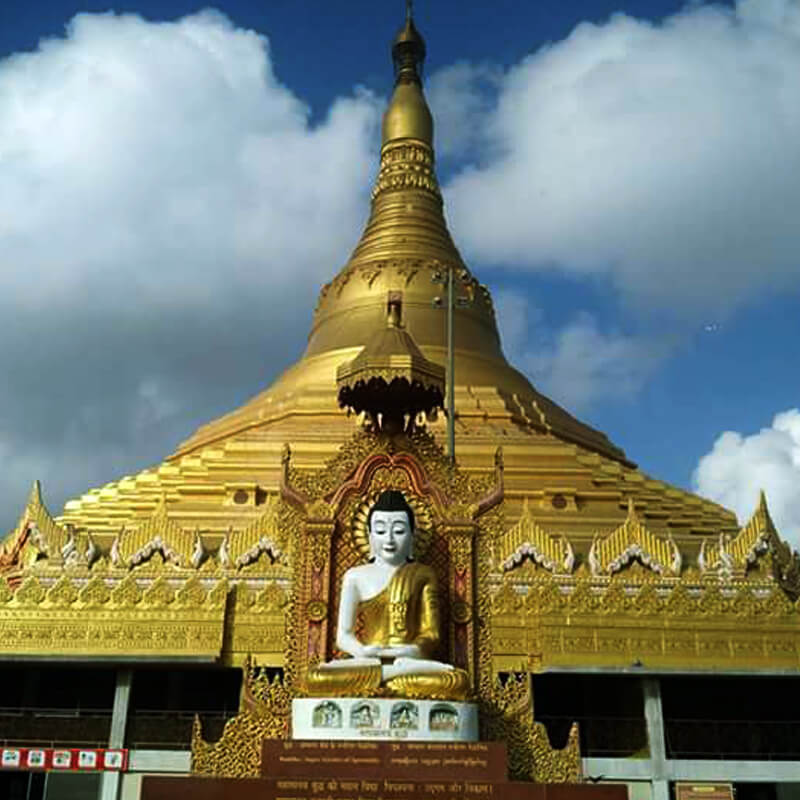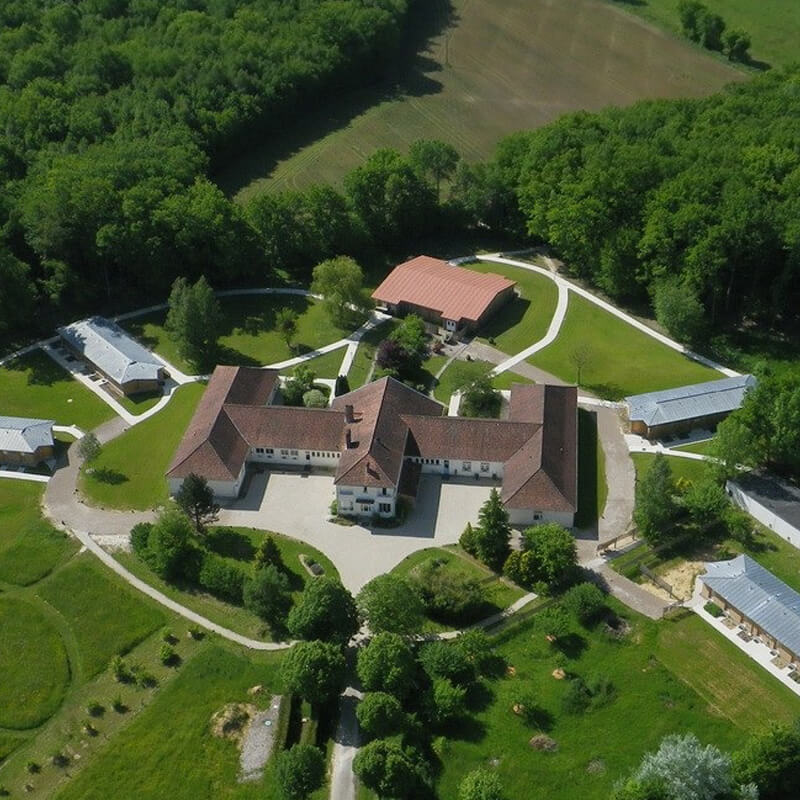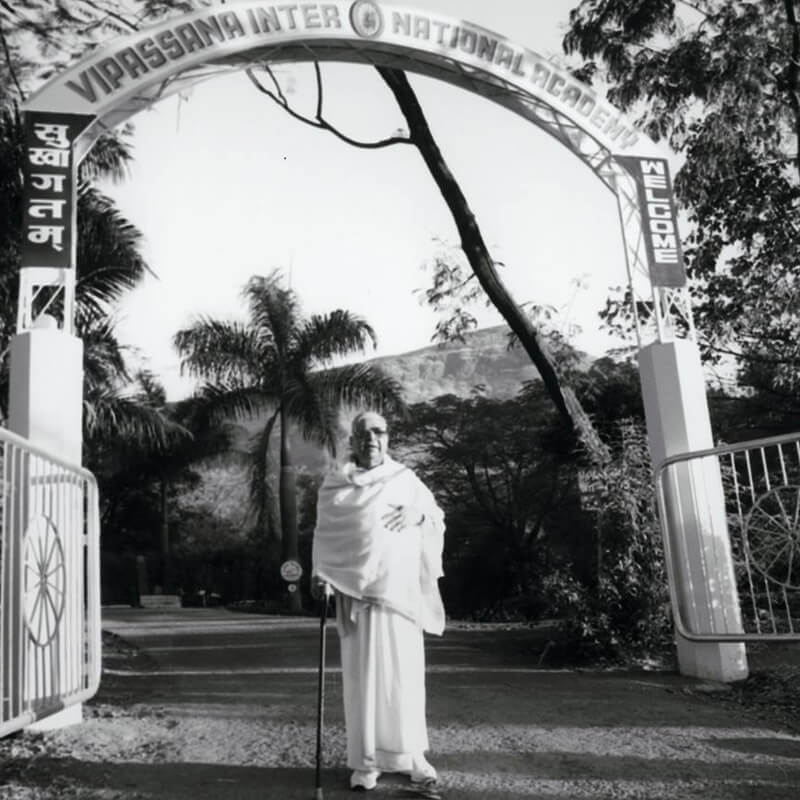On 12th June evening, Goenkaji gave a talk at the Eagles Hall in Fort Bragg, California. The audience included a group of venerable monks and nuns from a nearby monastery. After the talk, one of the monks mentioned that his first experience of meditation was with Goenkaji.
The Dhamma Caravan's next destination was Ashland, Oregon but it was not possible to cover the distance in one day. Therefore, it was decided to stop at a campground on the way along the Pacific Coast. Along the way the Caravan took a small detour so that Goenkaji and Mataji could see a "Drive-Through" tree. Because the motor homes could not drive through the tree, Goenkaji walked from the parking lot to visit the 2400-year-old Chandelier Tree. Its trunk had a diameter of about 31 feet. Goenkaji lovingly touched its trunk: the pure tradition of Dhamma that is more than 2600 years old had come from the other side of the earth and touched a tree that probably took birth at the time of Emperor Ashoka who spread the message of Dhamma far and wide.
The small town of Ashland has many old meditators. They had organized a one-day course at the Hidden Spring Wellness Center on 15th June. Goenkaji went there to answer questions from the students sitting the course. In the evening, Goenkaji gave a public talk to a capacity crowd at the Unitarian Church. He explained that by the practice of Vipassana, one learns at the experiential level that every vocal or physical action that harms others starts with an impurity in the mind making one agitated and miserable. Thus, one understands that one should live a moral life not only for the benefit of others but also for one's own peace and happiness.
There is an active regional committee of old students who organize regular group sittings, one-day courses and non-center ten-day courses in the area. They met Goenkaji the next day in his motor home.
The Dhamma Caravan reached the Dhamma Kuñja centre at 1:00 p.m on 17th June. A ten-day course was in progress at the main centre property. Two one-day courses had also been organized for the next two days for which huge tents were put up at the front of the property to accommodate all the visitors including the one-day course students. Students participating in the ten-day course at Dhamma Kuñja were fortunate to learn Vipassana from Goenkaji himself. Later, Goenkaji met the trust members of Dhamma Kuñja. They had many questions about the ongoing construction at the centre. Goenkaji emphasized the need to use donation money carefully.
The next morning, he gave a telephone interview for a radio station in Mendocino. Goenkaji gave the example of Ashoka to show how the Buddha's teaching has the potential to help the whole world. Ashoka had a huge empire that extended from modern-day Afghanistan to Bangladesh. After he started following the Buddha's teaching, he promoted the practice of Vipassana in his empire. During his reign of more than twenty-five years, different sects lived together peacefully. There were no communal riots. There were no foreign invasions. He assured his neighbours in his famous rock edicts that he had no imperial ambitions and he only wished that they follow Dhamma, which he often referred to as "righteous living". Ashoka once went away for more than three months to practice meditation seriously. He went to modern-day Rajasthan, which was more than a thousand miles away from his capital, Pataliputra (Patna). It was a testament to his efficient Dhammic administration that his empire remained secure, safe and peaceful during the entire time that he was away.
After the interview, Goenkaji answered questions from the one-day course students. In the evening, Goenkaji returned to Portland where a large crowd gathered to listen to his practical wisdom at the Smith Memorial Centre Hall at Portland State University. In the question-answer session, someone asked about death. Goenkaji replied that if one learns the art of living a happy and peaceful life then one automatically learns the art of dying peacefully.
The next day, Goenkaji gave Vipassana to the students of the second one-day course at Dhamma Kuñja and answered their questions. He gave personal interviews after that. In the evening, he travelled to St. Martin's College in Lacey to give a public talk. Goenkaji said that the purpose of Vipassana is to generate, uphold and enhance human values. The understanding of spirituality was limited to the two dimensions of sense doors and sense objects before the Buddha. He discovered the third dimension of sensations (vedanā) to give a complete understanding of our existence.
Narrating how he came in contact with the Buddha's teaching, Goenkaji said that his migraine was a blessing in disguise as it became the cause for his meeting Sayagyi U Ba Khin for the first time. When he took his first course he realized what sages all over the world meant when they said, "Know thyself." Before Vipassana, he would often think, "What is this 'Know thyself'? Of course, I know myself. I am Goenka, S. N. Goenka!" After Vipassana he understood the true meaning of "Know thyself". By practising Vipassana, one understands oneself not just at the intellectual level but also at the experiential level. One understands what this mind-matter phenomenon that one keeps calling "I" truly is.
People often think that the cross-legged posture is the only posture used for meditation. This is one of the reasons why they are hesitant to take a Vipassana course. It is true that sitting cross-legged offers stability to the body and one can maintain this posture for a longer time. Hence, it is suitable for meditation. But one can sit in any posture that keeps one comfortable for a longer period of time. If one requires a backrest or chair because of some disease or disability, one is provided with these aids during the course. One practises Vipassana to train one's mind. Hence, there is no insistence on any particular posture. It is important, however, that one keeps one's neck and back straight. Even after one adapts a seemingly comfortable posture, some discomfort may be experienced because of the nature of purification process. When an old saṇkhāra of aversion comes up on the surface it manifests as an unpleasant sensation on the body. A painful sensation is not always because of a saṇkhāra coming up on the surface but it could be because of some other reasons such as one's posture or the weather or diet or disease. Whatever the cause of a sensation, one has to observe it with equanimity to avoid the formation of new saṇkhārā.
One meditator wanted to know how to differentiate between pain that indicated some physical illness or damage and a painful sensation due to saṇkhārā. Goenkaji replied that one must seek medical treatment whenever necessary. However, it is important to maintain equanimity. Even when the pain is due to a physical ailment, if one reacts with aversion then one is making new saṇkhārā and generating misery for oneself. The ideal way is to maintain equanimity towards this pain while seeking proper medical treatment.
One of the questions at the end of the talk was about combining Yoga and Vipassana. Goenkaji replied that a Vipassana practitioner may practise the āsanas (postures) and prāṇāyāma. However, one should not mix any meditation practice from Yoga with Vipassana.
Goenkaji was invited to give a talk to the business people at the Rainier Club the next morning. In his brief address, Goenkaji talked about his own life before and after Vipassana. He told them how worldly success at an early age made him tense and miserable. He would often smile in social situations, maintaining a façade of politeness even when he was extremely angry. This anger would explode once he reached home and his family members bore the brunt of it and suffered as a result. Talking about his life before Vipassana, Goenkaji said that he was a bad example as a CEO. He used to believe that he was successful because his employees were afraid of him. He terrorised his staff and felt that if he made his employees fearful he could get more work out of them.
Vipassana taught him self-awareness. This inner awareness brought him in touch with the truth outside which led to more outer worldly success. More importantly, he became aware of the truth inside and it began to give him immense peace and happiness. After he started practising Vipassana, his whole attitude changed. He started to regard his staff as collaborators in his business. He began to care for their welfare. His business increased and he became more successful. But, above all, he became more peaceful. The Buddha's teaching brought light into his life.
In the question-answer session, Goenkaji was asked how to judge a particular teaching and teacher because meditation is often associated with various cults and gurus who exploit their followers. Goenkaji assured the audience that Vipassana was not a cult and that there was no scope for blind obedience in Vipassana. Vipassana is not a cult and it has no characteristics of a cult. There is no coercion to join a course or to remain a meditator. One is asked to judge the technique for oneself by giving a fair trial to it in a ten-day course. There is no fee charged, and therefore, no question of financial exploitation by a guru. Neither the Principal Teachers nor their assistant teachers get any remuneration for their service. All donations are entirely voluntary without the slightest coercion. There is no blind adherence to a philosophical belief. Participants in a Vipassana course are encouraged to return to the society and to fulfil their duties in a more responsible manner. There is no effort to create a closed commune that is separate from the rest of society.
Lucia Meijer was the director of the North Rehabilitation Facility (NRF), a low security jail, in Seattle when she started implementing Vipassana there about five years ago. Since then, she has taken many ten-day courses and now gives Dhamma service at Dhamma Kuñja. She drove Goenkaji and Mataji to NRF on 21st June, which was the mettā day of the ten-day course in progress there.
Goenkaji answered questions from the participants as well as from the jail staff. One inmate asked, "This is a hypothetical question. Suppose I am boxing. I don't have any aversion towards my opponent. And I have an opportunity to deliver a knockout punch and I can deliver it with all love and compassion. What should I do?" Goenkaji laughed and answered, "Give a knock-out punch to your mental defilements and live a happy life!"
In the evening, Goenkaji gave a public talk at the Seattle Town Hall. He explained that all religions teach how to live a moral and upright life. Morality and purity of mind is the inner essence of all religions. (Sayagyi U Ba Khin used to say, "Purity of mind is the greatest common denominator of all religions.") Various rites, rituals, ceremonies, festivals, dogmas and philosophical beliefs are the outer shell of all religions. Unfortunately, most of the followers of religions ignore the inner essence and give importance to the outer shell. This attachment to the outer shell causes conflict.
In Vipassana one finds the common essence of all religions. It is a scientific way of observation without allowing beliefs or past experiences to colour the observation. A ten-day course is the beginning of this scientific process of self-awareness.
In his public talk in Ashland, Oregon Goenkaji had explained that a spiritual prison of ten-days is necessary to learn Vipassana as one needs to practise continuously to learn the technique properly. Sometimes, inmates of a worldly prison are fortunate and get Vipassana in the prison. The North Rehabilitation Centre in Seattle is one such jail where Vipassana has helped so many inmates. "It was almost as if I was here by divine appointment," said one ex-inmate while speaking during Goenkaji's visit to NRF again on the last day of the course for 'graduation' of the inmates. Many former inmates also came to give an account of their experiences. One ex-inmate put the practical nature of Vipassana tersely and beautifully when he said, "It works if you work! Try it."
Goenkaji gave a brief talk. Often in life one feels that one is alone and helpless. But after taking a Vipassana course, one gets two great friends, Anapana and Vipassana, who help one to keep in touch with oneself. Time and again, research has shown that merely taking the criminals off the streets and putting them behind bars has neither reduced crime nor helped with recidivism. Prisons are often called correctional facilities in USA. Goenkaji told the inmates, "No one else can correct you… you have to correct yourself."
It was a joyous moment for these inmates to meet Goenkaji. One inmate asked what the "S. N." in S. N. Goenka stood for and what it meant. "S. N." stands for Satya Narayan. Literally it means, "Truth (is) God". Another prisoner asked where power came from and Goenkaji replied that it comes from within. When one has eradicated all the negativities from the mind, one becomes the most powerful person on earth. Echoing Goenkaji's statements about one's influence on others, an inmate said, "When you shine, people around you shine".
Goenkaji was invited to speak at the Evergreen Buddhist Temple in Kirkland, WA. His talk was simultaneously translated into Mandarin by an old student. To a question whether Vipassana is closer to Mahayana or Hinayana, Goenkaji explained that Vipassana is neither Mahayana nor Hinayana, it is Dhammayana. The Buddha didn't teach either Mahayana or Hinayana, he taught Dhammayana. Later on different branches developed but the fundamental teaching of the Buddha such as the Four Noble Truths, Tilakkhaṇa (Three characteristics: impermanence, suffering and non-self), Noble Eightfold path and Paticcasamuppāda (Dependent Origination) are common to all the different schools of Buddhism. These schools are like different branches that take their nutrition from the same basic teaching of the Buddha of which Vipassana is the quintessence.
All followers of the Buddha accept the law of cause and effect. This was his great discovery. Practising Vipassana, one experiences how this law of cause and effect works; how a cause results in an effect, which, in turn, becomes the cause for the next effect. Thus, the chain of misery continues. The Buddha found the link, sensations, where this cycle of cause and effect can be broken. Vipassana is a training to break the cycle of misery at this crucial link of sensations by systematically learning to observe sensations, remaining equanimous with the understanding of their impermanent nature.
During the question-answer session, a question was asked about the Bodhisatva vow. Goenkaji explained that a Bodhisatva (Bodhisatta) vow is taken in front of a Sammā Sambuddha. The Sammā Sambuddha examines whether the person who is taking the vow is sincere and has all the requisite qualities and determination to strive for Buddhahood. Only then does he pronounce this person as a Bodhisatva. Whether someone has taken the Bodhisatva vow or whether one is practicing to become an arahat, it is important to purify the mind. This is essential to accumulate the requisite pāramī to become an arahat or a Bodhisatva.
Goenkaji travelled from Seattle to Vancouver on 23rd June. That evening he gave a public talk in Hindi to a crowded hall at the Guru Ravidass Community Centre Gurudwara. Goenkaji has great reverence for Guru Nanak Dev and often quotes him during his ten-day course Hindi discourses. Guru Nanak Dev showed by his own example that a householder can be a great spiritual person and also established a tradition of householder spiritual teachers. During his childhood Goenkaji studied in a Khalsa school from the age of eight to sixteen. Most of his schoolteachers were Sikhs. Sometimes he would go to the sangat in the local gurudwara (Sikh temple) and listen to Guruwani (verses from Granth Sahib, the holy book of Sikhs). The practice of Vipassana clarified the meaning of many of those verses. He explained how the Sikh Gurus had broken down the abominable caste system. Then he quoted the Buddha, "Just as the water of different rivers after merging into the great sea have no separate identity, there is no division of class and caste among those who follow Dhamma."
Goenkaji recounted how one of his school teachers had explained the meaning behind the five items (kakkas) that each Sikh is supposed to carry on his person: long hair and beard so that all look similar and that there is quick identification of all as brave warriors; a comb to care for one's hair so that one keeps hair clean and doesn't look like a matted-hair ascetic; a sword to fight against injustice; an undergarment as a reminder that power comes with the responsibility not to take advantage of women; and a steel bracelet to remind one, the moment he raises the sword, of his responsibility not to harm innocent people, women and children. Such was the response of the audience that in spite of the long travel day, Goenkaji's talk and question-answer session lasted more than two hours.
On 24th June morning, Goenkaji went to the IT Productions' studio in Vancouver where he was interviewed by Ms. Sushma Dutt. She asked him about all the adulation and admiration that comes his way because he is a renowned guru. Goenkaji said that the adulation and admiration was inconsequential and that he did not consider himself a guru in the sense of one who will liberate anyone who surrenders to him. The attitude of such a guru is that the followers are weak and, therefore, they must depend on him for liberation. Such a guru often exploits his followers. Goenkaji described his role and that of any Dhamma teacher as a guide who has walked on the path of Dhamma and had benefited from it. A Dhamma teacher is a giver-of-the-path (mārgadātā), not the giver of liberation (muktidātā). This is what the Buddha declared about himself-Tumhehi kiccaṃ ātappaṃ, akkhātāro tathāgatā. One who has walked on the path and become liberated will show you the path but each person has to walk on the path oneself.
When asked about Sayagyi, Goenkaji replied that he was impressed by Sayagyi's saintly nature right from the first meeting. But it turned into a teacher-disciple relationship only after he took a ten-day course under Sayagyi's guidance. As he continued to walk on the path of Dhamma, his respect for Sayagyi increased and he developed an immense sense of gratitude. Respect and gratitude for one's teacher are natural. A real teacher becomes happy not when his disciples worship him but when they follow his teaching.
Many years ago, Sayagyi U Ba Khin declared confidently that the clock of Vipassana had struck. This was evident this evening when Goenkaji gave a talk at the Plaza of Nations in Vancouver. This was Goenkaji's first visit to Vancouver. The large crowd listened with rapt attention as he spoke eloquently on the waterfront.
He explained that though Vipassana is widely known as a meditation technique, it is actually an objective observation-observation of the changing nature of the body and mind. Other meditation techniques lack any awareness of the reality about the mind-matter phenomenon that one keeps calling "I" or "mine". Vipassana is awareness of the mind-matter interaction at the experiential level, that is, at the level of sensations. It is self-awareness within the framework of the body.
Goenkaji has been interviewed by a number of radio stations since his arrival in North America. In Vancouver, he was interviewed by Rafe Mair on CKNW on 25th June. Goenkaji explained how the Buddha discovered this technique twenty-six centuries ago, exploring the reality within the framework of the body. Rafe asked whether family members saw changes in Goenkaji after Vipassana. "Well, of course, the results are here and now."
Rafe wondered how it was possible to do his job, as a radio talk show host dealing with controversial issues without getting angry. How could he articulate his concern without anger? Goenkaji replied that when the habit of blind reaction goes away, there is positive action and one is more effective in articulating one's concern. Whenever necessary, Vipassana helps one to take strong vocal or physical action without generating anger.
That evening, Goenkaji returned to the Plaza of Nations to give a Dhamma talk to the expatriate Chinese community that is showing increasing interest in Vipassana-the quintessence of Sākyamuni Buddha's teaching. Goenkaji described how Vipassana is the Noble Eightfold Path. On every ten-day course, one takes refuge in the Triple Gem and follows the five precepts scrupulously. This is sīla. One trains one's mind to remain focused on one point, without craving or aversion, which is sammā-samādhi. Then one learns paññā, understanding reality as it is, not just as it appears to be.
Similarly Tilakkhaṇa (Three Characteristics) of impermanence, suffering and non-self are not Buddha's philosophical beliefs but the nature of all compounded things. The three characteristics are experienced by each one who starts taking steps on the path of scientific exploration shown by the Buddha. The Buddha used to say that he was above all philosophies. Hence, these three characteristics should not be taken as Buddhist philosophy.
The Sākyamuni Buddha discovered and proclaimed the truth that is applicable to one and all. It is not merely for the Buddhists. Mere belief in anattā (non-self) doesn't stop one from reacting with aversion to unpleasant sensations and with craving to pleasant sensations. It is the investigation of the reality within that reveals to us that everything in the field of mind and matter is ephemeral and without any essence. If it is "I" then I must have mastery over mind and matter. But one finds that one has no control over these phenomena. Out of ignorance one remains deluded that one of the five aggregates is the soul or the 'I'. Anattā is not a philosophy but an experiential knowledge.
Suññatā (shunyatā) has two meanings: first, at the worldly level, it means that everything in the field of mind and matter is devoid of any lasting essence, which one can hold on to and say that this is "I" or "my soul". Second, one may refer to the experience of nibbāna as Suñña.
Goenkaji ended his talk by making a humble request to the followers of different branches of Buddhism as well as people from different religious backgrounds to learn the practical aspect of the Buddha's teaching.
Throughout the long tour of North America, expatriate Indian meditators have cooked Indian vegetarian food for Goenkaji and Mataji. This ensures that they eat the food that they are used to and can continue to spread the message of Dhamma without compromising their health as they rush from place to place. On 26th June, Goenkaji and Mataji thanked the meditators who cooked food for them during their stay in Vancouver. These meditators cook not only for Goenkaji and Mataji but also for the Caravan members who travel with them. Many of these selfless servers do not even ask for private interviews with Goenkaji. Goenkaji and Mataji call these women Annapurnas (one who gives food).
(to be continued)






